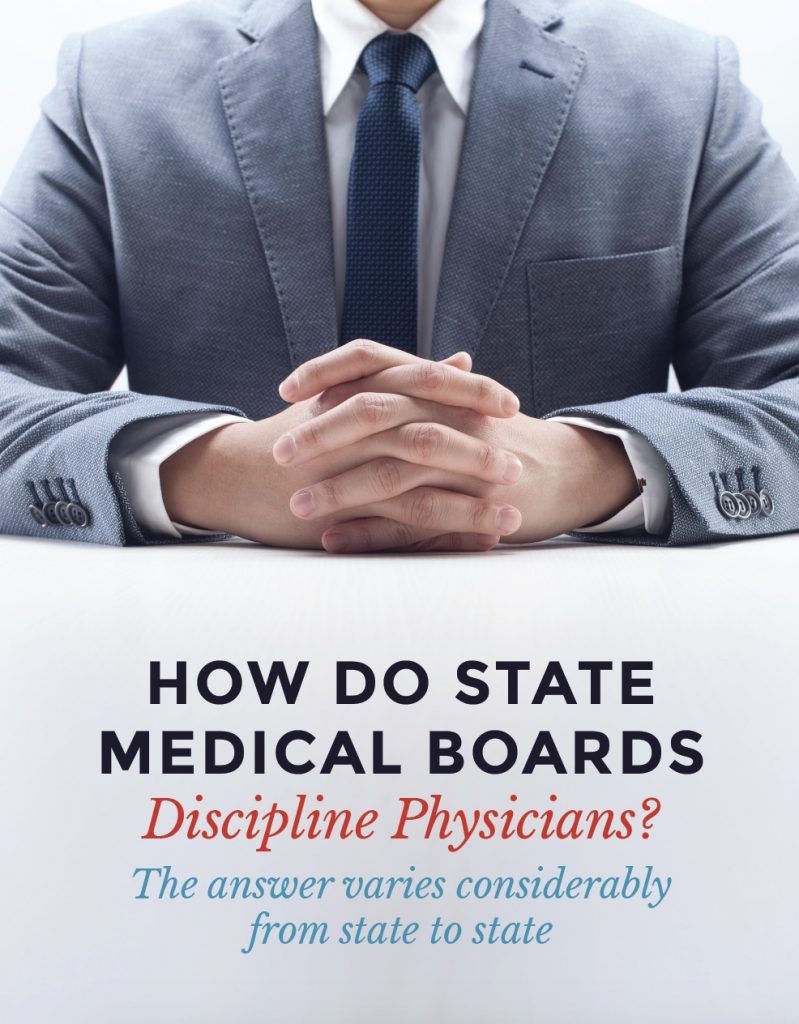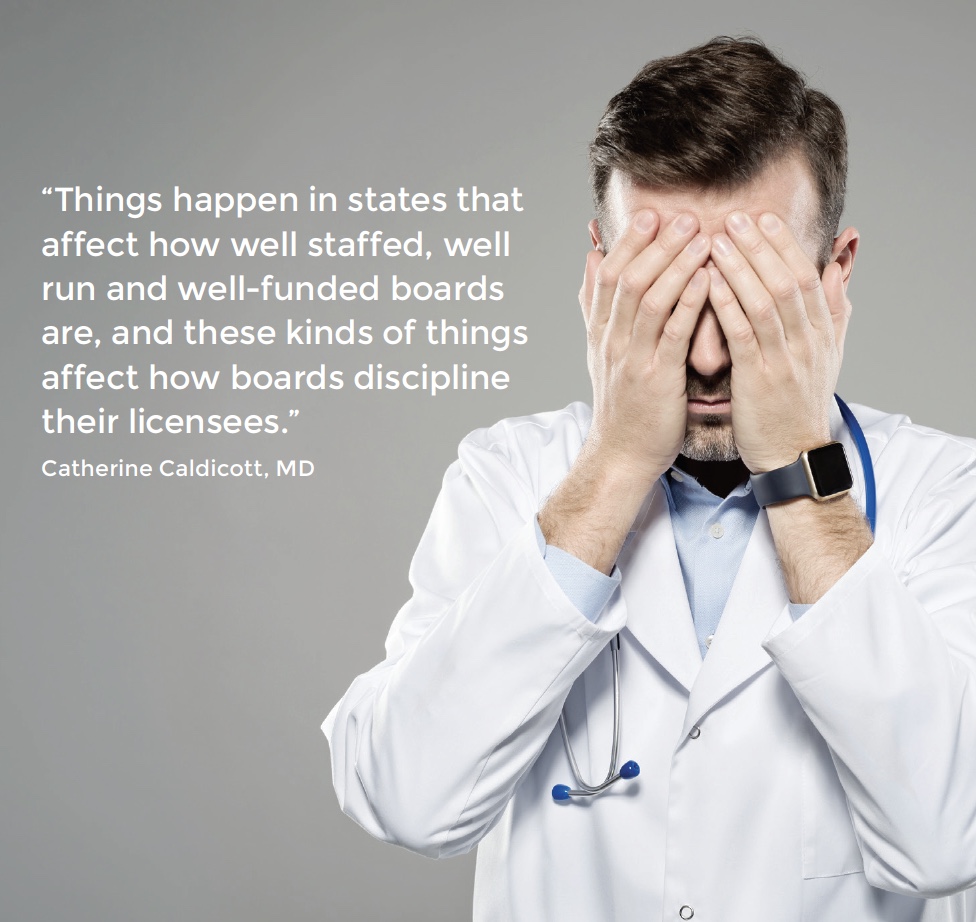How Do State Medical Boards Discipline Physicians?
How Do State Medical Boards Discipline Physicians?
The answer varies considerably from state to state

On the surface, the nation’s medical regulatory system seems to provide an uniform blanket of protection over all residents. No matter where they practice, physicians nationwide are governed by their state’s Medical Practice Act; licensed by their state medical board; and disciplined by that same board, according to state guidelines, whenever they fail to live up to their legal and ethical obligations.
But take a closer look and you discover that the national blanket of protection is more of a patchwork quilt. There is a surprising degree of inconsistency among the nation’s 70 independent medical boards, both in the approach they take to discipline and in the decisions they make. A 2017 study of state-by-state variations in physician disciplinary actions analyzed nearly 275,000 “adverse events” reported to the National Practitioner Data Bank (NPDB) between 2010 and 2014. Ninety-four percent of these were disciplinary actions, the rest were malpractice payments. The study, published in BMJ Quality and Safety, found a four-fold variation in the annual rate of serious disciplinary actions among state medical boards. A Public Citizen study the year before found a five-fold variation.
John A. Harris, MD, one of the co-authors of the BMJ study, told Consumer Reports, “I don’t think it’s intentional, but there are states where you get off easier, and there are states where you get firmly dealt with.”
WHAT ACCOUNTS FOR THIS VARIABILITY? Is it related to the kinds of complaints each board receives, variations in state laws or board composition? It’s impossible to know. Any attempt to get more granular is fraught with difficulties, in part because it’s hard to get comparable information from state to state. For one thing, there are no national standards for reporting disciplinary actions; each state makes its own decisions about what to track. And even cases that are similarly classified often vary markedly in their details. Consider two male physicians disciplined for sexual misconduct. One may be a first-time offender who told inappropriate jokes, the other a repeat offender who regularly fondles female patients. No one would argue that the same discipline should be applied in both cases.

Still, there are clear indications that disciplinary actions vary considerably from one board to another. This is most apparent when physicians fall under the jurisdiction of more than one board. Whenever a physician is disciplined, the FSMB alerts other states where the same practitioner is also licensed. According to Catherine Caldicott, MD, a consultant with more than 15 years’ experience in the field, “It’s then up to each state to decide what to do, and it can take a year or more for the second state to take action.” In one case, notes Stephen Schenthal, CEO and founder of PBI, a disciplined physician who had gone for many years without further incident, moved to another state. His new board revisited his original offense and had his license revoked. In other cases, of course, the situation is reversed. As a recent editorial in BMJ Quality and Safety noted, “After losing their license to practice in one state, physicians have been granted permission to practice in others, although with restricted practices.”
There are many possible explanations for variations in board actions. The authors of the 2017 BMJ study found a consistent relationship between rates of serious disciplinary actions and the ratio of board members to physicians. That ratio varies widely. The Texas board has 19 members overseeing more than 57,000 doctors (0.33 board members per 1,000 physicians), for instance, while Kansas has 15 board members and only about 6,000 physicians (2.5 members per 1,000 physicians).
Numerous other factors may also play a role. FSMB’s 2016 “U.S. Medical Regulatory Trends and Actions” report devotes 53 pages to a state-by-state catalog of varying board characteristics, including the number of physician and non-physician board members, the number of terms members serve, how many full and part time investigators and attorneys the boards employ, the medical disciplines under boards’ purview, budget authority and decision-making autonomy, to name just a few. To date there has been no research exploring the relationship between these factors and board discipline.
Caldicott believes that differing levels of funding and other types of state support help explain many inconsistencies among boards. “Politics and legislatures affect how well staffed, well run and well-funded boards are,” she explains, “and these kinds of things affect how boards discipline their licensees.” In the end, says Caldicott, given limited resources, “It’s often a matter of priorities. In some states, right now, the only cases boards can really take on are those involving inappropriate prescribers and relationships between physicians and pharmacists, because they’re up to their eyeballs in those kinds of cases.”

The disciplinary process itself also affects the outcome of cases, and ultimately state law determines how the process works. That law, the Medical Practice Act, is written by state legislators who are sensitive to constituent attitudes towards government regulation, consumer protection, budgets and a host of other concerns—all of which differ from state to state.
The sheer size and complexity of a state’s health care system plays a role, too. In some states, especially those with fewer physicians per capita, the disciplinary process remains relatively simple and straightforward, with board members and physicians interacting directly with each other early on. More populous states, with greater concentrations of physicians, tend to develop more extensive disciplinary structures, requiring more staff and less direct involvement by board members.
California, for instance, is the most populous state in the union with the greatest number of doctors. It’s board is well staffed, but the volume of disciplinary cases often demands the combined efforts of both medical board investigators and officers from the state Department of Investigation. These peace officers handle both the medical board overflow as well as any cases likely to involve criminal charges. The California Attorney General’s office also gets involved early on, assigning deputy attorneys general whenever a case
in opened.
The enforcement process in California dictates that much of the investigation work be completed before the physicians themselves become involved. By the time physicians are called in, investigators have reviewed all relevant medical records, interviewed the complainant, and when necessary, consulted with expert witnesses. Board members themselves don’t become involved until either a settlement agreement is reached or an administrative law judge has written an extensive decision concerning the facts of the case, the law involved and the proposed disciplinary action.
WHATEVER THE REASONS, MANY ARE TROUBLED BY THE LACK OF CONSISTENCY AMONG THE NATION’S MEDICAL BOARDS. “It doesn’t seem fair if a licensee in one state is disciplined more harshly than a licensee in another state for the same infraction,” says Caldicott. “And if all regulatory agencies are meant to protect the public, then there should be more uniform standards.” But she hastens to add an important caveat. “If there are standards for boards,” she says, “then boards deserve to have the funding and resources they need to live up to those standards.”
Standardized reporting might be the place to start, say the authors of the BMJ editorial. “Standardization of data collection and categorization of disciplinary findings are an essential first step in any process that will help states benchmark against others,” they write. Such standardization would help state medical boards identify how and why their decisions vary from other states. It could also facilitate improvements in the disciplinary process, especially if combined with long-term tracking of disciplined physicians. Either way, the authors conclude, “more and better data can only improve the decision-making.”
